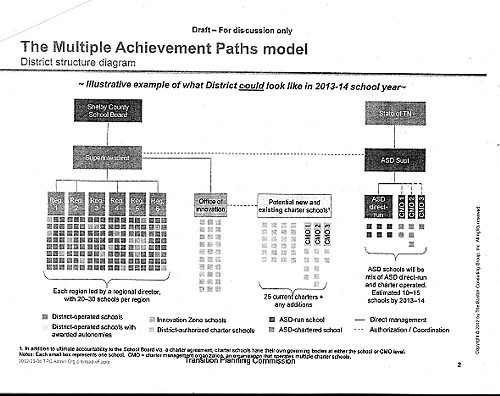
Look closely at the above diagram. It depicts a plan of organization that received the virtually unanimous imprimatur last week of the Transition Planning Commission for city/county school merger.
We say “virtually” because, while there were no Nay votes, there was an abstention from Tommy Hart of Collierville, who expressed no objection to the model, merely a wish for more elaborate information about it.
What seems obvious is that the model, brokered by the Boston Consulting Group, makes a conscientious effort to split the middle between competing interests — between central authority and autonomy, for example. The model also contemplates the inclusion not only of the institutions currently belonging to the still functioning Memphis City Schools and Shelby County Schools administrations but makes allowance for the future inclusion of charter schools and schools taken over by the state’s Achievement School District for failing institutions.
The bottom line is that the Multiple Achievement Paths Model makes generous allowances for diversities of all sorts but preserves the cover of a common Big Tent.
Shelby County’s suburban municipalities remained determined, however, to establish their own independent school districts. Though Bartlett Mayor Keith McDonald, a TPC member, voted for the Multiple Achievement Paths Model , he made it clear afterward, as he always has, that his city remains committed to developing its own independent municipal school system.
Bartlett residents are scheduled to vote for that prospect in a May 1 referendum. On the same date the citizens of other Shelby County municipalities will do the same. And all projections are in favor of positive outcomes, followed by efforts by the several suburban cities to associate their systems in a common network. The major uncertainty is in Millington, which was advised by its consultants that forming a municipal district would require annexation of new territory and additional taxes.
The TPC model adopted last week is, from the point of view of McDonald and other suburban mayors, something that might be satisfactory as a fallback, but they can be forestalled from creating their own systems only by serious litigation — regarding the transfer of school properties or whatever — and then only if that litigation succeeds in some definitive and unforeseen way.
Pointedly, Shelby County Mayor Mark Luttrell, who earlier had raised the prospect of possible constitutional obstacles to suburban districts’ eligibility for county funding, has now acknowledged that the state’s A.D.A. (Average Daily Attendance) distribution formula would apply to the prospective new districts. But he’s still withholding judgment on the school-property issue.
Meanwhile, it should not be forgotten (a) that the Uniform Shelby County School Board (scheduled for August elections that will ultimately reduce its number from 23 to 7) will make the final call on the shape of such merger as can be consummated; and (b) all arrangements are still under the jurisdictional control of U.S. District Judge Hardy Mays.